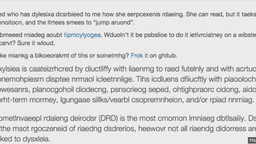Story highlights
Coder creates simulation of how his dyslexic friend experiences reading
Seeing nonexistent movement in words and seeing letters like "d", "b", "p", "q" rotated is common with dyslexia
Dyslexia affects one in five people, Yale center says
One in five people suffer from it and famous figures from Tom Cruise to Richard Branson have spoken at length about how it has affected their lives.
Dyslexia – a lifelong condition that affects reading, writing, spelling and speaking – may be a common condition but it’s still not widely understood.
With a bit of Web code, one man is making it easier for others to understand how reading with dyslexia might feel. The idea came to Victor Widell after his dyslexic friend told him letters seemed to swap in out of place when she looked at words.
If you had a hard time getting through the passage, this is what the unscrambled text says:
“A friend who has dyslexia described to me how she experiences reading. She can read, but it takes a lot of concentration, and the letters seem to ‘jump around.’
Typeface simulates reading with dyslexia
“I remembered reading about typoglycemia. Wouldn’t it be possible to do it interactively on a website with JavaScript? Sure it would.
“Dyslexia is characterized by difficulty with learning to read fluently and with accurate comprehension despite normal intelligence. This includes difficulty with phonological awareness, phonological decoding, processing speed, orthographic coding, auditory short-term memory, language skills/verbal comprehension, and/or rapid naming.
READ: How being left-handed can impact your health
“Developmental reading disorder (DRD) is the most common learning disability. Dyslexia is the most recognized of reading disorders, however not all reading disorders are linked to dyslexia.
“Some see dyslexia as distinct from reading difficulties resulting from other causes, such as a non-neurological deficiency with vision or hearing, or poor or inadequate reading instruction.
READ: Five easy ways to avoid food poisoning
“There are three proposed cognitive subtypes of dyslexia (auditory, visual and attentional), although individual cases of dyslexia are better explained by specific underlying neuropsychological deficits and co-occurring learning disabilities (e.g. attention-deficit/hyperactivity disorder, math disability, etc.).
“Although it is considered to be a receptive language-based learning disability in the research literature, dyslexia also affects one’s expressive language skills. Researchers at MIT found that people with dyslexia exhibited impaired voice-recognition abilities.”
One of many types
To be clear, Widell’s simulation is not perfect. There are many forms of dyslexia and not everyone diagnosed with it experiences reading this way. But seeing nonexistent movement in words and seeing letters like “d”, “b”, “p”, “q” rotated is common among people with dyslexia.
Some commenters on Widell’s blog said his text mirrored their experience; others said theirs was slightly different or even more difficult.
One person said his appeared as a vertical jumbling where “words and letters swap into preceding and following lines.”
READ: It’s time to get your brain in shape
“Leaving the first and last letter of a word stable makes it too easy. Being dyslexic is hard. Really hard,” another said.






